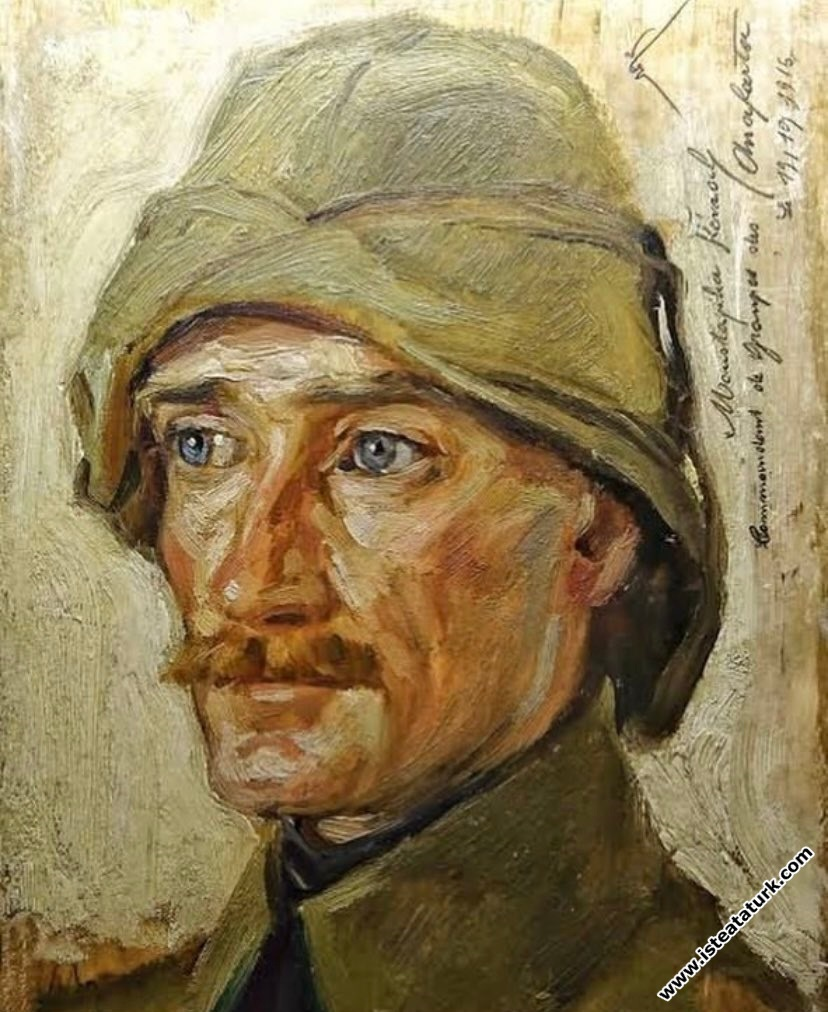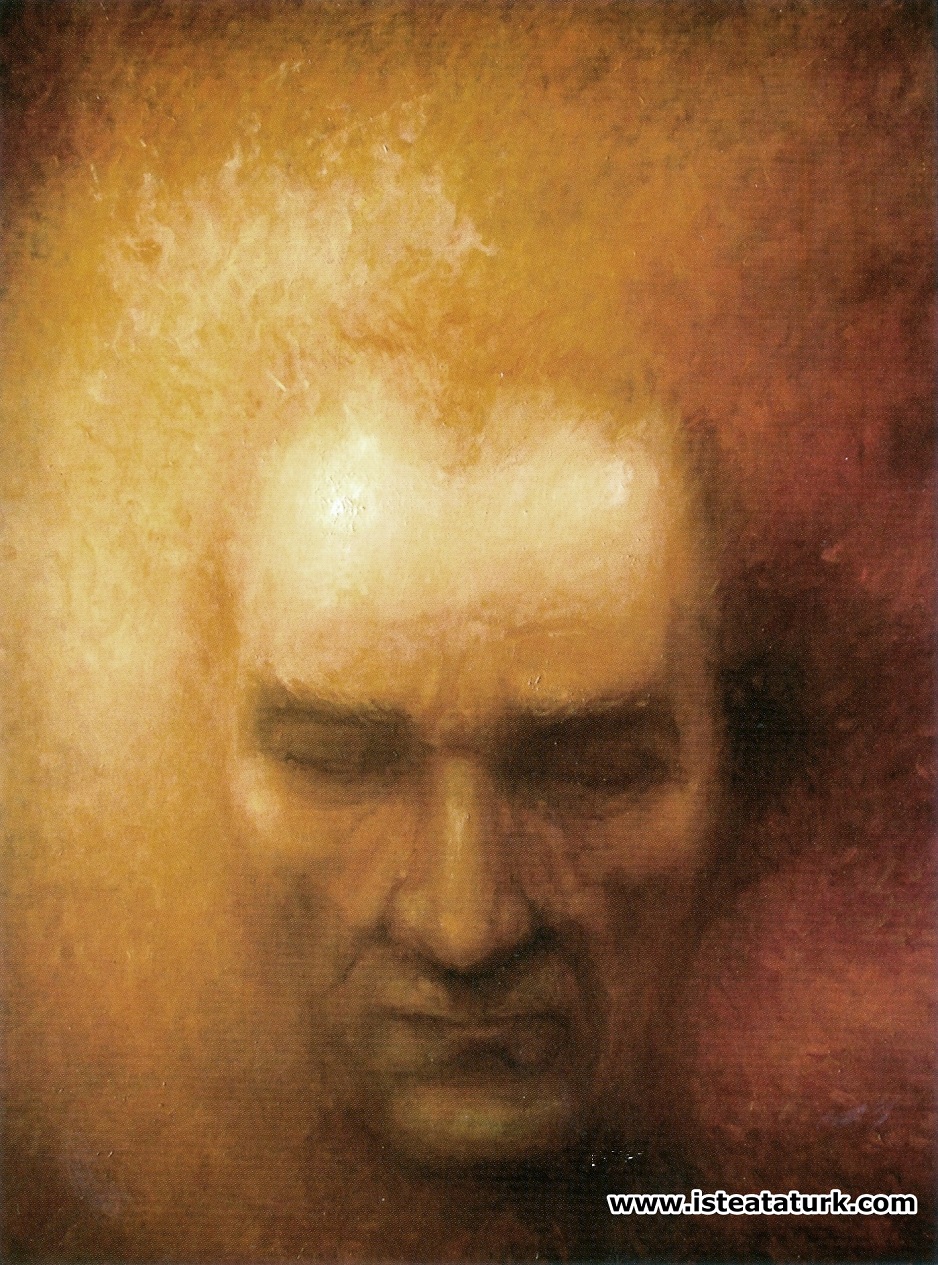
F. Korkut Uluğ, Mustafa Kemal, 10 November 1938... At 09:05... Immortal
Character Size
F. Korkut Uluğ, Mustafa Kemal, 10 November 1938... At 09:05... Immortal
F. Korkut Uluğ
ARTISTIC BACKGROUND
Electrical Engineer (ITU 1968). He has been painting in oil since 1985. He is closely interested in art history and philosophy, western and eastern painting arts, contemporary physics, Anatolian Sufism and Zen Buddhism.
His works are in the collections of Turkish Ministry of Culture, Çanakkale Naval Museum, İzmir State Painting and Sculpture Museum, İstanbul Technical University, Ege University and private institutions and individuals.
I - ) COMPETITIVE AND MIXED EXHIBITIONS
1-) ESBANK, ''YUNUS EMRE'' Painting Exhibition –III /1986
2-) TR MINISTRY OF CULTURE AND TOURISM - TARİŞBANK Painting Exhibition on "The Birth of the National Anthem and the War of Independence" /1987
3-) TEKEL Traditional Painting Exhibition – III - 1989
4-) ESBANK, ''YUNUS EMRE'' Painting Exhibition -VI /1989
5-) TEKEL - Traditional Painting Exhibition - XIII /1999
6-) SNBA, HALL 2005, CARROUSEL de LOUVRE / PARIS (Special Artist Award)
7-) SNBA, HALL 2006, CARROUSEL de LOUVRE/ PARIS (Special Artist Award)
8-) SNBA, SALON 2007, CARROUSEL de LOUVRE / PARIS (Special Artist Award)
9-) BEAUX ARTS BEZIERS, Salon International des Arts / BEZIERS-FRANCE (Special Jury Award) - 2008
10-) ''SOUPED-UP PONTIAC '' MUSEUM OF NEW ART (MONA) DETROIT –USA. - 2008
11-) BINDALLI ART GALLERY - Commemorating RA with portraits -2007
12-) İZMİR STATE PAINTING SCULPTURE MUSEUM, Kuva-yı Milliye-2008 (National Channel Support Exhibition)
13-) ÇANAKKALE PAINTING COMPETITION. - 2008
14-) İZMİR MUNICIPALITY ART CENTER ''Atatürk's Children'' Exhibition, 2009 İZMİR
15-) GALERIE ARTEST, PARIS 2009
16-) ART EN CAPITAL, GRAND PALAIS, PARIS 2009
17-) ANKARA ABSTRACT GALLERY, IZMIR ARTSHOP 2011. ''Little Things''
18-) SNBA, HALL 2012, CARROUSEL DE LOUVRE, PARIS
19-) IZMIR PAINTING SCULPTURE MUSEUM, October Parade - 2013
20-) SNBA, HALL 2013, CARROUSEL DE LOUVRE, PARIS
21-) ASF-ALACATI ART FESTIVAL, IZMIR - 2015
22-) IZMIR PAINTING Sculpture MUSEUM GALLERY FAIR –'' ATATURK AND THE REPUBLIC MIXED EXHIBITION', - 2016
23-) IDE - INTERNATIONAL PAINTING EXHIBITION Adnan Saygun February 2017
II - ) PERSONAL EXHIBITIONS
I-) İŞBANK ART GALLERY/İZMİR - 1989
II-) "WAR OF ÇANAKKALE AND THE BIRTH OF KUVA-YI NATIONALITY" PAINTING EXHIBITIONS:
1-) 18 MARCH UNIVERSITY / ÇANAKKALE - 2001
2-) ÇANAKKALE MILITARY MUSEUM - 2001 ÇANAK
3-) HARBİYE MILITARY MUSEUM / ISTANBUL – 2001
The entire collection of 18 oil paintings was donated to Çanakkale Military Museum in 2001. It is exhibited in this museum indefinitely.
III-) "THE BLACK HEARTED, BLACK INSTRUCTIONS" PAINTING EXHIBITION, ADNAN FRANKO ART GALLERY / IZMIR - 2002
4-) ''LIVING MUSTAFA KEMAL ATATÜRK''
PORTRAIT ART EXHIBITIONS FROM YOUTH TO IMMORTALITY:
ISTANBUL TECHNICAL UNIVERSITY / ISTANBUL - 2007
STATE MUSEUM OF PAINTING AND SCULPTURE / IZMIR - 2007
NAMAZGAH BASE ( 9 Pictures) / ÇANAKKALE - 2008
EGE UNIVERSITY ART GALLERY IZMIR - 2008
5-) MUSTAFA KEMAL ATATURK PORTRAITS
- ARTSHOP ART GALLERY IZMIR - 2014
- IŞIKKENT EDUCATION CAMPUS IZMIR - 2014
LIVING ATATURK
%2080X100cm.jpg)
MUSTAFA KEMAL 1902, Thessaloniki - Istanbul 80 X 100 cm. oil painting on canvas
Leaving his beloved mother and his hometown Thessaloniki, chaotic Macedonia and his childhood memories, he comes to Istanbul, the Military Academy.
Even in those years, his head was always full of worries and problems for the future of the empire and country. He is in a spiritual restlessness at school. He is inexplicably resentful, sad, and rebellious. He has always been distrustful of authorities. It's very clever. The inquirer has a mind that sees and reflects the facts like a mirror. He is very self-confident and has a cynical side because of all these features.
He can't sleep at night because his head is constantly dealing with country problems. He is in financial and spiritual loneliness. These are emotional, heartfelt and youthful depressions that have not yet determined their goals.
But this does not lead him to defeat. On the contrary, he constantly works and tries to train himself. He believes that he will have a mission and will do great things. The nobility of human dough is already here.
%2090X100%20cm.jpg)
MUSTAFA KEMAL 1905, Istanbul 90 X 100 cm. oil painting on canvas
He finishes the Military Academy as a staff captain. The photo he took in Beyoğlu to put on his uniform and send it to his mother is really eye-catching. It is the expression of a young man who is fully handsome, has developed facial features, and looks to the future with bright eyes, despite all the dark days, with hope. His mustaches are fashionable "alabros" mustaches with two ends pointing upright.
He frequently meets with his friends for the purpose of the salvation of the homeland. At that time, he was so betrayed by a close friend that his world darkened. He is arrested and exiled to Syria. His mother waits in vain for her "son who will become Pasha". He will not hear from her for a long time. For Ms. Zübeyde, the sorrows, pains and ordeals she will suffer for a lifetime are just beginning.
His life and observations in Damascus will mature him and influence him for life. There he will come to the conclusion that the real danger for his country is religious reaction and bigotry.
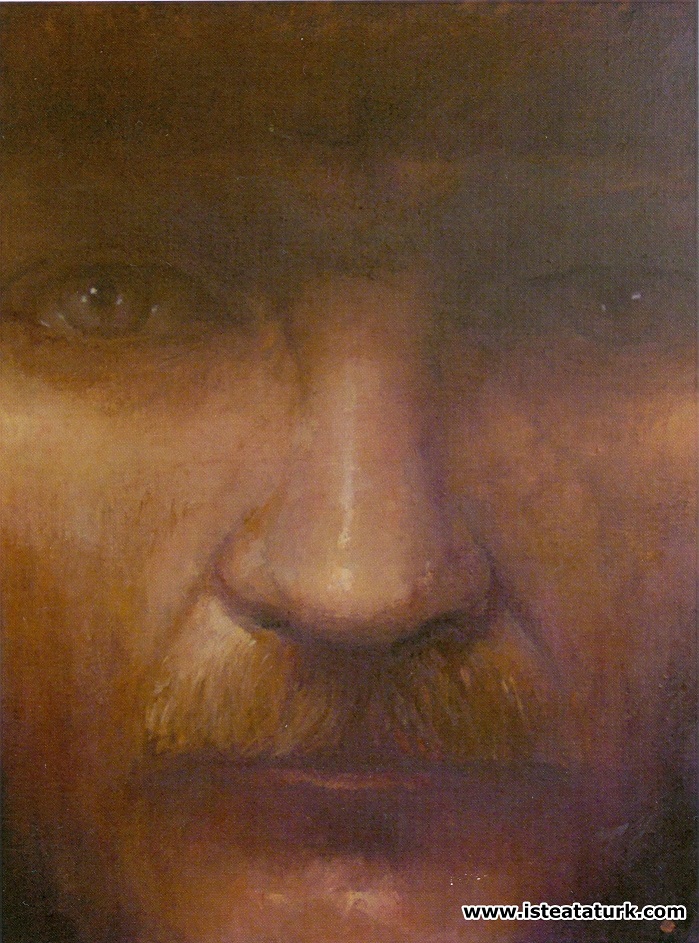
MUSTAFA KEMAL 1908, Damascus 75 X 100 cm. oil painting on canvas
Mustafa Kemal, the best of the Empire in Thessaloniki III. He succeeds in securing a mission in his army. The leaders of the "İttihad ve Terakki", the most powerful organization of the time, cannot adequately evaluate his establishment of his organization and undertaking revolutionary work here. Moreover, Enver Bey, one of these leaders, does not like Mustafa Kemal's maverick, assertive character. A lifelong conflict begins between them. These conflicts become a psychological obsession in both. Luck is on Enver Bey's side. The organization carries out the 1908 revolution and seizes the administration. Enver Bey became a star and became a hero. Mustafa Kemal was discredited. Mustafa Kemal withdraws and speaks very little. His future is almost chained by Enver Bey.
This mood becomes the inner urge that stimulates and stimulates him instead of depressions in his being.
Events are pregnant with developments that will reveal a much more powerful Mustafa Kemal. However, this is; It takes a decade of pain, pressure, hope and despair.
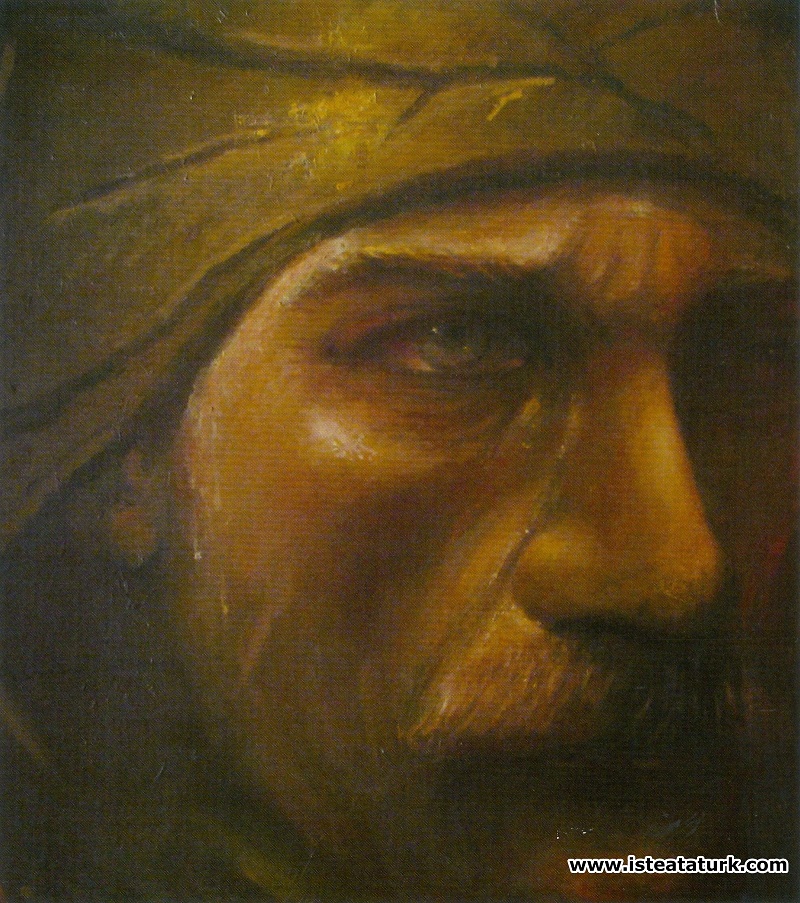
MUSTAFA KEMAL 1915, Çanakkale 100 X 90 cm. oil painting on canvas
The historical birthplace of Mustafa Kemal, who will determine the destiny of a nation and be one of the most important leaders recorded in history, is Anafartalar, "Kemalyeri". The Dardanelles Wars are a fate-defining phase.
One day of war can age a person by ten years. Especially if it is not only his life but also the life and responsibility of tens of thousands that is put on the scales... Then, as Mustafa Kemal said, the hearings and sufferings of the decision-maker, who is kneaded in a responsibility that is "heavier than death", can make him "superhuman" in one day.
The fact that he is ready to give his life at any moment and that he walks around under enemy fire as if there is a magic protecting him transforms him into a fairy tale hero.
He hunkered down, slumped, turned pale, and hadn't slept for days. He constantly fights with his tired soldiers. He is cold-blooded and brave. Thousands of young people mingled with each other die and get injured before their eyes.
What have these eyes sunk into the pit have seen and what will they see...
%20100X90%20cm.jpg)
MUSTAFA KEMAL 1907, Diyarbakir - Aleppo 100 X 90 cm. oil painting on canvas
After Çanakkale, Mustafa Kemal is no longer the old Mustafa Kemal. The bloody, painful and tired memories of the war he fought victoriously give him nightmares. The rulers of the state, especially Enver Pasha, are worried about his prominence and try to erase his successes.
Mustafa Kemal expects to be greeted as a hero in Istanbul and the title of "Pasha" and more important duties. It is in vain. Finally, he realizes that he has nothing to do in Istanbul. Mustafa Kemal is alone. He has bitter feelings, but with his defiant mind and intuition, he still believes he has a lot to do.
XVI. As a corps commander, he will go to the Caucasian fronts and take back Bitlis and Muş from the Russians. VII. He is appointed to the command of the army. He first goes to Diyarbakir and then to Aleppo. At that time, the Hashemite Sheriff, who was descended from the prophet, united with the British with the ingenuity of the famous British spy Lawrence and surrounded the Turkish Soldier in Medina. Muslim Arabs shoot Muslim Turks in the back. Together with the soldiers of Fahrettin Pasha, who made the famous defense of Medina, they drink the rain water and eat grasshoppers because of hunger. But Medina is not delivered.
Mustafa Kemal sees that Anatolian and Rumeli Turkish children are being broken in the Arabian peninsula. Of the remaining forces, he pulled those under his command safely to Aleppo and did what no army commander could do. He writes a documented report that expresses the facts not only in terms of military but also about the general situation of the country and proposes a solution, and appoints his deputy, and returns to Istanbul.
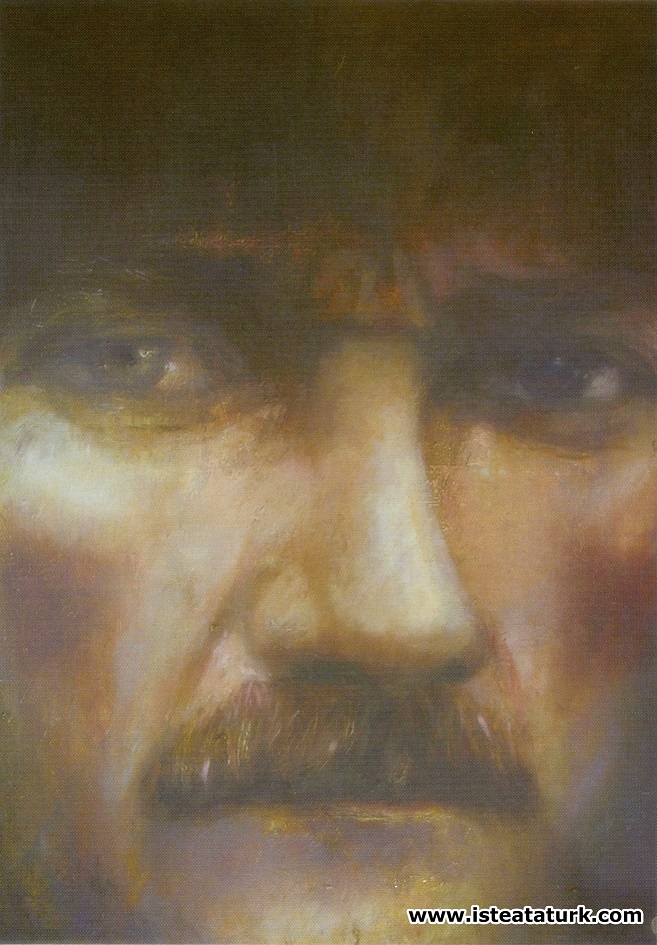
MUSTAFA KEMAL 1918, Istanbul 100 X 70 cm. oil painting on canvas
There is no "obedient spirit" in Mustafa Kemal. He does not bow to events and circumstances, does not accept them as they are. He knows how to fight negativity... The whole army is disbanded. All the material and moral support of the country has been exhausted. Everything has collapsed. Everyone is pessimistic.
But there is a man. This man is Mustafa Kemal. That's the soldier. His head won't admit defeat. He can re-create an army.
This man who does not bow down and does not surrender is the man who has the power to re-shape the conditions and events, and who reveals not only his head but also his real intelligence, will and passion for this cause. Mustafa Kemal is insistent. It's the direction maker. Of course, he is exuberant in terms of emotion and excitement. But he knows how to suppress them. He is a man of calculation, mind, balance and strategy. There is a soy yeast in the dough. He kneads himself from this dough. Even if he is alone, he is the one who is not surprised, can combine his inner strength with external possibilities, and opens new paths.
He is a true leader who has the power to make himself.
“They go as they come!” He is the "only man" who can say. The only entity he can trust can only be his people.
%20100X90%20cm.jpg)
MUSTAFA KEMAL 1919, Samsun - Ankara 100 X 90 cm. oil painting on canvas
Trusting the public is not just words. In the army, things go by order. In order to win the public, it is necessary to know him and convince him. If the cause is "the nation's liberation war", then it is necessary to speak in the language of the nation so that the people will believe those who speak that language and know in advance the suffering they will suffer. Let him accept the war willingly. For this purpose, after great efforts, he goes to Samsun with the duty of army inspector. He makes his first contact with the public in Havza. First litigants; Ali Fuat Pasha, Kazım Karabekir Pasha, Rauf Orbay and Colonel Refet, and the more he enters the Anatolian soil, the better he mingles with his people. He begins to gain the support of most of the notables of the people. Congresses are held first in Amasya, then in Erzurum and Sivas, and the National Struggle begins.
The Sultan and the Istanbul Government have awakened. Under the pressure of the British, they first recall Mustafa Kemal and then issue an arrest warrant for him. He has to leave the military. He leaves his rank and titles. He lives in Erzurum, the storms that this event has created in his soul structure and cannot be revealed. Despite the enthusiasm of the people, the events he encountered in Erzurum once again left him alone and helpless. It even comes to the stage of giving up. But such temporary moments of euphoria also exist in the lives of gods, heroes, and prophets. These are the situations that if those who encounter them know how to settle accounts and beat them, they become the cause of new paths and new exits. With his self-confidence, bravery, foresight, reason and determined stubbornness, which are in Mustafa Kemal's dough, he easily overcame them and abandoned everything, as he said.
The people present this lowly, unmarked, plain-clothed leader with a fur-collared hood as a gift, Mustafa Kemal now has a new title...
%20100X90%20cm.jpg)
MUSTAFA KEMAL 1920, Ankara 100 X 90 cm. oil painting on canvas
April 23, 1920 is the date when the Turkish National Liberation Movement established its own state. It is the day when the Sultan and his government in Istanbul are not recognized by the public. The Turkish Grand National Assembly was established as the true representative of the people. It is the day the freedom flag was actually unfurled. Today, Mustafa Kemal is very weak, tired and distressed in his civilian clothes. He reads his first speech, which lasts for four hours, from the pulpit of the assembly. With this speech, Mustafa Kemal appears as a great soldier, as well as a great man of reason, logic and will, a statesman. Thus, the nation finds its own assembly and leader. At that time he was 39 years old. Under his presidency, the first people's government is established and the principles of the Republic of Turkey are laid down. The liberation, freedom and happiness of the country will be achieved by the power of the people under the administration of this assembly. Everything is not in the name of the sultan and religion, will be done on behalf of the nation. Today, Mustafa Kemal appears before the nation not as a revolutionary dictator, but as an enlightened people's leader who knows and senses better than the people what the people expect, despite the ignorant people, but for the people. He knows that there will be many obstacles in his way, that the people will be provoked, and that this struggle will take a long time with his realistic and far-sighted nature... He is ready no matter what...
%20100X85.jpg)
MUSTAFA KEMAL 1921, Ankara 100 X 85 cm. oil painting on canvas
The parliament was established and the blind and lame work was started. However, Mustafa Kemal and a handful of patriotic comrades with him are in a circle of fire. Mustafa Kemal was declared a "rebel" by the Sultan and the Istanbul Government and a death sentence was issued. As if it wasn't enough that most of the country was occupied, the Greek Army, which was supported by the British in every way, started to advance continuously in the west from İzmir, where it landed. With British money, forces in the name of "green army" are established by the Sultan and the traitors who support the sharia, and rebellions are started everywhere. The forces loyal to Mustafa Kemal that can resist them are still very weak.
They are unprotected at the Ankara Agricultural School, where Mustafa Kemal set up headquarters with his friends. They have to protect themselves.
Mustafa Kemal is sleepless, works until the morning. At times he feels helpless. Halide Edip writes in her memoirs:
"... The moonlight poured in through the curtainless window and mixed with the raw glow of the only kerosene lamp, giving Mustafa Kemal's face a dead color. His eyes were surrounded by blue circles, their eyes like the eyes of those who burned in Dante's hell. They are in indescribable pain, sadness and despair. As he saw those who acted together with the enemies, he was plunged into deep sadness and resentment...''
Why is it that Mustafa Kemal's unwavering faith and gripping will will open the roads to freedom. He cries out: "Friends!, we will never bow down. We will go to the end on the path we have taken. We will not surrender and we will try to be successful. We will defend our rights against domestic and foreign enemies. If we have no hope of defeat in the final situation, then we will take shelter under a Turkish Flag and the freedom of our people." We will give our lives for it!”
%2080X70%20cm.jpg)
MUSTAFA KEMAL 1922, Izmir 80 X 70 cm. oil painting on canvas
The Greek Army comes as far as Ankara. Our army is getting stronger. Anatolia recovers. First, the rebellions are suppressed, and the unimaginable brutality shown to the Kuva-yı Milliye commander and his soldiers is avenged. The traitors who will shoot the patriots in the back are destroyed. This would be a great morale booster. Now is the time to oppose the powerful colonial powers and their tool, the army. Mustafa Kemal suppresses the contradictory voices within the roof of the National Assembly. It gains full power now.
The Turkish Nation is essentially an army nation. It is a noble nation that is fond of its freedom, dignity and honor. Despite all the poverty and poverty, it is because of this rich feature that, in the footsteps of his great leader, he suddenly becomes united, becomes stronger and begins to defend his existence fully.
Its story is very deep, it is very long to tell, in an environment of pain, poverty, betrayals and profiteers, the Anatolian people, pouring their pain into themselves, reveal their patient, ascetic, humble and humane, valiant, honorable resistance and fight... three years as a whole with his commanders... After the victories of İsmet Pasha, the commander of the Western armies, the commander who will strike the real blow is a peace-loving, humane, courageous, sensitive commander, who fights to defend, and then looks like a "god of war". The commander who can move, Mustafa Kemal Pasha, the Pasha of his people becomes the Commander-in-Chief in 1921 and after Sakarya the "Great Offensive" begins. This is an attack with unbelievable speed and success, in which all armies break like a storm...
The Greek Army is defeated. During the retreat, the entire western Anatolia is in fire. When Turkish soldiers enter İzmir, the city is on fire. Still, Mustafa Kemal orders the captive enemy officers and soldiers to be treated humanely...
%20100x90.jpg)
MUSTAFA KEMAL 1923, Republic 100 X 90 cm. oil painting on canvas
The war of freedom against the dominant powers of the world has been won. Mustafa Kemal, who set out as a warrior in the heart of the nation alone, ascended to his throne in the heavens, in the hearts and dreams of his people, with a superhuman aura of fame, glory and honor that history bestowed on very few people. While he attributes the victory to his people with all his humility, the people glorify all the gains of victory by ascribing moral values to him.
Since his youth, Mustafa Kemal starts to realize the revolutions that mean the real freedom, material and spiritual development of the Turkish people, reaching the level of modern civilization, to establish the Republic of Turkey, what has been in his mind and soul since his youth. That's the real battle. But unfortunately, in the implementation of this, his paths begin to separate with his closest comrades in arms. Despite this, he becomes the leader of the birth of a new nation from the ruins and chaos with his unshakable belief in the way he believes, his stubborn and rational personality, his ability and power to direct and persuade people with his delicate policy. He fights big. Although he is a democrat in terms of his thoughts and beliefs, he is autocratic in terms of character. In order to realize his revolution, he must be realistic and authoritarian. But he never aspires to dictatorship. It's not for himself He is authoritarian in whatever he believes will benefit the people. In a backward, uneducated country, it is not possible to act otherwise for the benefit of the people, and the will of the people cannot be fully achieved without the development of the people. No matter what anyone says, it also has a purpose, and that is: a democratic republic based on the full will of its people.
Declares the republic on 29 October 1923 with a staff that believed in the republic. The name of the newly born state becomes the "Republic of Turkey". The parliament elects the first president: Gazi Mustafa Kemal.
%20110X110%20cm.jpg)
MUSTAFA KEMAL 1924, Revolutions 110 X 110 cm. oil painting on canvas
After establishing the Republic, it is time to establish democracy and establish its modern institutions. These are the revolutions that will fundamentally change the administrative, political and cultural structure of Turkish society that has been going on for centuries. Otherwise, the national liberation movement may become sterile and return to its old days. Gazi and his friends take important and strong steps in this direction. This is a very tough challenge. Mustafa Kemal has revealed his existence for this cause. Now it is truly revolutionary... It suppresses all the forces that will oppose it. After the abolition of the sultanate, he abolished the "caliphate" without taking the risk of causing an internal and external reaction. Thus, he separates the affairs of state and religion. It cuts the lifeblood of those who use the religion of Islam for their political and personal interests and put pressure on society because "religion commands it like that". It establishes the secular state order and never compromises on this issue. This is the path to the true freedom of your people. The religion of Islam finds its true meaning in the "field of belief". Sharia courts are abolished, the work of sects is prohibited. Madrasahs are closed and a modern education system is started. Outdated mentality and bigoted influences are cleared from all state institutions. The state form that has been ruling for centuries and based on "sharia" comes to an end.
Mustafa Kemal: " Countries that are not civilized and lack the ability to create civilized works in science, social life and economy are doomed to lose their freedom and sovereignty." He says and exclaims like a testament: "Young people! The future is yours. We founded the Republic, you are the one who will glorify it and keep it alive ..."
%20100X90%20cm.jpg)
MUSTAFA KEMAL 1925, Depression Year 100 X 90 cm. oil painting on canvas
The fragmentation within the leading cadre of the National Struggle becomes a crisis. Two opposing groups are formed. Mutual suspicions deepen every day. Gazi believes that his old and close friends are plotting against him. Sad things happen between them. Despite this, Gazi tries multi-party democracy. Democrats want these differences to be expressed. However, the application does not happen that way. Democracy efforts fail. There is no end to the conflicts between the rulers. The people are ignorant, neglected and poor. Endless wars have melted and finished the nation. At that time, Turkey was almost a relic with its social and economic structure. These remains should be cleaned and rearranged according to the requirements of the age. The people have no hope other than the personality of Gazi Mustafa Kemal for the orientation and development of the primitive life to a new order.
In those days, the new Turkey does not need many parties, but a single and mighty will and its leadership. This chief is only Mustafa Kemal. Historical conditions and necessities push him to this mission. Revolutions had been made, many more were to be made, and this was how it would be.
%20100X90%20cm.jpg)
MUSTAFA KEMAL 1926, Sheikh Said Rebellion and Izmir Assassination 100 X 90 cm. oil painting on canvas
It is these days that the eastern rebellion erupts. The leader of this rebellion, named Sheikh Said, spread the rebellion to many cities in our eastern region in a week, with provocations such as "saving the religion, establishing the sharia, and bringing the caliphate". The followers of this sect and their men and slaves join the rebellion. Despite the provocations, they cannot get the support of the Kurdish tribes that are the majority in this region. This movement is not ethnic, it is a bigoted movement. While there were successive rebellions against the National Struggle in the west, there were no rebellion movements in the region. During the Lausanne agreement, the people of this region – of Kurdish origin – stated that they lived together with the Turks through their representatives and that they wanted to continue living like that.
For him, the Sheikh Said rebellion is a "reactionary" movement based not on Kurdish nationalism, but on the way of Allah, supposedly for the sake of religion, but actually based on his own sect's beliefs and interests.
The Republican government suppresses the rebellion within two months by declaring martial law in the rebel area and sending sufficient forces. The ringleaders are caught and tried in the Independence Courts and executed.
%20100X90%20cm.jpg)
MUSTAFA KEMAL 1930, Menemen Incident 100 X 90 cm. oil painting on canvas
With the emergence of the Turkish Revolution and Mustafa Kemal's uncompromising and fierce defense of the secular and modern state understanding, the second movement of the reactionary sects, which went underground and tried to maintain their strength, began with a bloody incident in Menemen in 1930. A bigot from Crete named Derviş Mehmet raises a green flag and calls the people to revolt. He gathers supporters from the townspeople. Kubilay, a teacher who is a reserve officer in Menemen, tries to stop them with a squad of soldiers. Derviş Mehmet is a savage blood drinker like those involved in all such movements. They easily dispose of Kubilay and martyr him with two soldiers. Derviş Mehmet cuts off Kubilay's head and puts it on a spear and performs in takbir sounds. Soldiers arrive at the scene and the rebellion is suppressed in a bloody way.
It turns out that the end of the matter is based on the sheikh of the Naqshbandi sect in Istanbul and his son. They are also punished. Gazi's reactions to these rebellions were very violent. Although it seems narrow-framed, Mustafa Kermal's overreaction to these bigoted movements is because he considers religious reactionary and bigotry as the greatest danger to the republic. "It's better to act first and smash your head, than wait to crush a reactionary movement," he says.
What pleases Mustafa Kemal is the hostility of the people's reactions to the rebellions all over the new Turkey. No sign of sympathy was seen anywhere in the country, as the government said. Even in the Sheikh Said rebellion. Every part of the people everywhere strongly oppose these religious reactionary demonstrations. They embrace the peace, tranquility and republic that were so hard to obtain.
.jpg)
MUSTAFA KEMAL 1933, A Lonely Man 100 X 90 cm. oil painting on canvas
In the tenth year of the Republic, he proudly enjoys the realization of his superhuman goals and the full development of his people. She is happy but feels so alone. In fact, he has been alone and alone since childhood. This is the fate of a leader but a true leader, of real geniuses. Like the loneliness of being on the top of the mountain...
French Journalist Madam Gaulis describes an observation as follows: "... She suddenly calmed down and she wanted music. Soldier and civilian relatives sitting around the mansion were summoned with their spouses.
At Mustafa Kemal's request, they started to sing old Rumelian folk songs about love, death and glorious wars, starting with the pestilence.
It was a music he loved since childhood. While the women sang, he hummed softly, in keeping with the heavy and often melancholic melody of the songs.
For a moment, and for the first time, Mustafa Kemal forgot the bitterness of the war and let himself go, remembering his past; He told the people around him about the first days of his childhood, his mother who loved him dearly, his youth, his first troubles and his first successes; He relived all this with the depth and vitality he gave to everything, stunned by the abundance of his natural data, and it was as if he had become that early young man..."
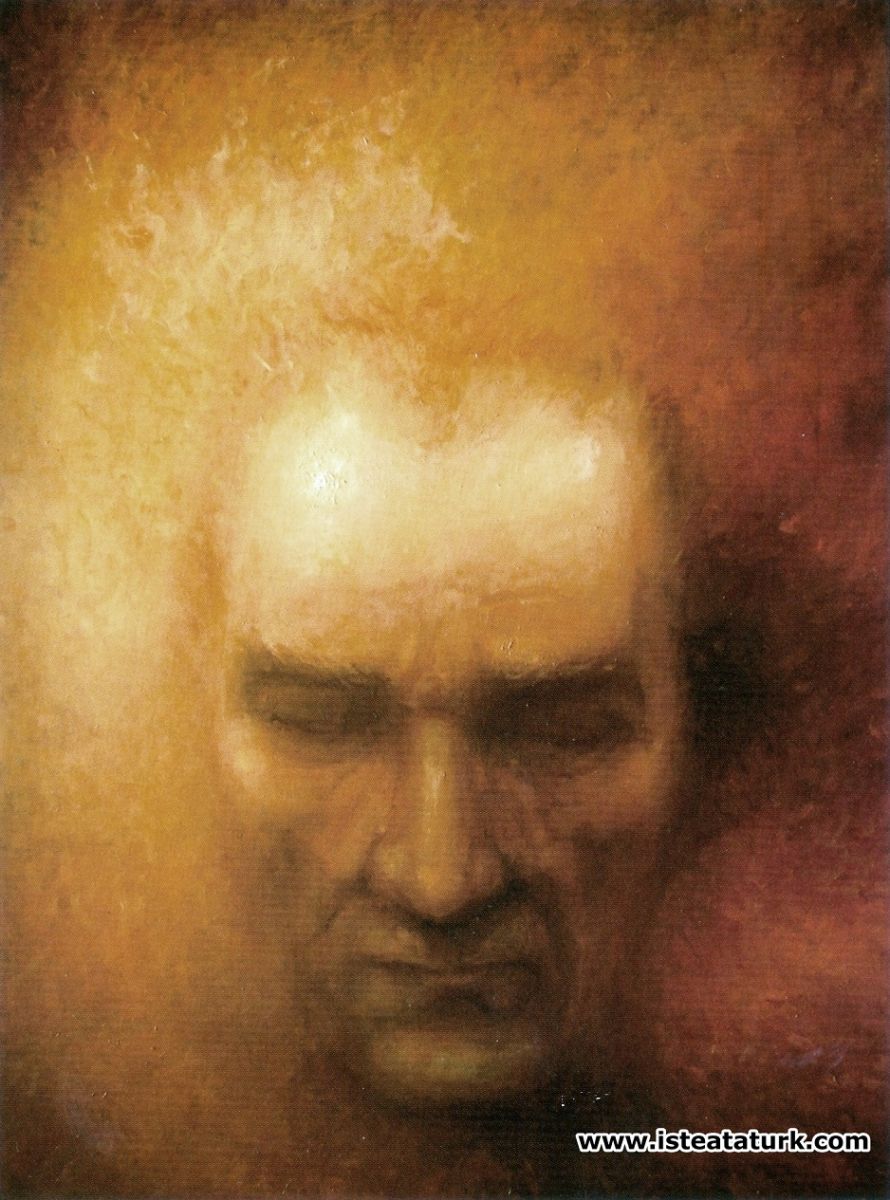
Mustafa Kemal, 10 November 1938... At 09:05... Immortal 120 X 100 cm. oil painting on canvas
PAINTER KORKUT ULUG TELL US ABOUT "LIVING ATATURK" EXHIBITION
"There is a hidden sadness in his penetrating gaze"
Uluğ said that when we look at our ancestor's face, he can see two different expressions, he said that he tried to feel like him while making portraits.
"I graduated from Istanbul Technical University in 1968. I am an electrical engineer. I have a professional life of about forty years. The first twenty years of my forty-year career have been like an engineer-painter, and the last twenty years have been like a painter-engineer," says Korkut Uluğ. Known for his oil-painted Atatürk portraits series, the artist is among the 10 artists participating in the exhibition at the Louvre museum. Korkut Uluğ's "Living Atatürk" series will be exhibited at the Izmir State Painting and Sculpture Museum starting this evening. The exhibition will last until 10 November...
- You say that in the last 20 years of your professional life, painting came to the fore...
Yes, painting came to the fore. But it created something beautiful in me. When both mind, intuition and emotion come together, I live very intensely. I enjoy doing this as much as I can. You have to experience the event, hear it, create it within you. When all these occur, they force you on their own; the rest is your feelings, experiences, intuitions, everything that you can't express with language. Painting just makes it like a porter.
- How?
- When I start a painting, it seems to be finished; because I am busy.
- You are working especially on the Battle of Çanakkale and the soldiers. Why?
- My curiosity about our recent history started to force me intensely on the Battle of Gallipoli on one occasion. There are not many people other than our military-origin masters who focused on the Battle of Çanakkale and the Kuva-yı Milliye after it. There has been no serious artistic work on this subject for eighty years. Besides our great masters, there are pictures of our late teacher Avni Erbaş in recent years. There are a few paintings by E. Hakkı Köseoğlu, but apart from this, there was not much painting. When I examine the Battle of Çanakkale, I see a great humanism that is not found in other wars. We can see this in the national struggle as well.
- Have you always worked on these subjects since you started painting?
- No, I was a landscape painter. I studied nudes and along with these works, I slowly started working on portraits. But he was a little late.
- How did you start making portraits of Mustafa Kemal?
- The beginning of Mustafa Kemal portraits was a bit delayed because it scared me a lot. First of all, Mustafa Kemal, let me tell you that portrait work is very difficult. If the artist does not know the main personality of the subject very well, it is not a portrait made by him.
- What impressed you the most?
- During the preliminary works, Mustafa Kemal's eyes impressed me a lot. All the psychological state and thoughts of a person are reflected in his eyes. If you look people in the eyes, you start to read inside. Mustafa Kemal's eyes are different, he has a very rich mood, he has a very noble stance and he has a head that works like hell. Now imagine a facial expression and an eye that reflects all of this. It is very difficult to examine this artistically, to scrutinize it and to reveal it to the extent of your ability. This job has been very challenging for me. By doing a lot of research, I tried to experience the environment he lived in and even put myself in his place and tried to perceive what he thought and felt in those important events.
- What were the results of your research on Mustafa Kemal's soul and physical aesthetics?
- I can say this about Mustafa Kemal about painting; He is a very handsome person since his early youth, and his self-confident, self-confident charismatic personality starts at a young age because he knows his own characteristics. It is also very beautiful in stature. The facial features are flawless. His looks are truly incredible. Mustafa Kemal's eyes are shehla. In a shhla gaze, their eyes are not parallel, but one of them is slightly offset. This gives a great meaning to Mustafa Kemal's gaze. When looking into the eyes, one of the eyes remains in the shadow and it is difficult to decipher the meaning of this eye. The shadowy eye reflects the hidden emotional aspects. The eye that receives light, on the other hand, brings out the formidable intelligence in him. When we look at our ancestor's face, we can see two different expressions. When people looked at such an eye, they were afraid to look into their eyes because they could not understand it.
- How is it reflected in the pictures?
- In these portraits, I try to reflect his human condition, emotional side, as well as his mind and intelligence. There are at least two different expressions in their eyes at the same time. In particular, the perception of my portraits by women and soldiers is very different.
- And why?
- It is very clear why the soldiers. Because they are the grandchildren of a military intelligence that they have seen during their education and accepted by the whole world, and because they share the same homeland with him, it is normal for them to experience intense emotions. I attribute the effect of women of all ages to their being sensitive and emotional. I believe in women before men because masculinity is destructive, warlike... The feminine is productive, beautiful, compassionate, creative. This is how I perceive femininity and most women have these features. Maybe that's why they showed more sensitivity.
- In your research you have always caught Mustafa Kemals other than the known soldier side.
- Mustafa Kemal wanted his hard structure and military side to come to the fore. I know that the moment he realizes that the photo has been taken, he immediately changes his facial expression and puts on a harsh expression in order not to upset them and to look strong, regardless of their morale. But when I look at the photos taken without her knowing, all I feel is that she feels alone. There is a sadness in almost all of my portraits and I shared this loneliness of her while I was making them.
- Do we need another Atatürk now?
- The name of the exhibition is the living Mustafa Kemal. We always need Atatürk, but not by turning it into an idol and always taking shelter in him. By loving him and understanding him... A person who understands Mustafa Kemal well is now Mustafa Kemal himself. I did not despair in the slightest because above all I am confident in myself. I keep our martyrs and Mustafa Kemal alive in my heart.
- You donated your Çanakkale Martyrs' painting series to Çanakkale Naval Museum.
- Yes, they are now the property of the museum, that is, the property of the public. All paintings in Çanakkale are dedicated to the martyrs of Çanakkale and the Kuva-yı Milliye. There, I tried to reveal the humanitarian dimension of the Dardanelles War.
Talk: Burcu Ilgin
We thank Mr. F. Korkut Uluğ for his contribution.
Other Atatürk Works of the Artist
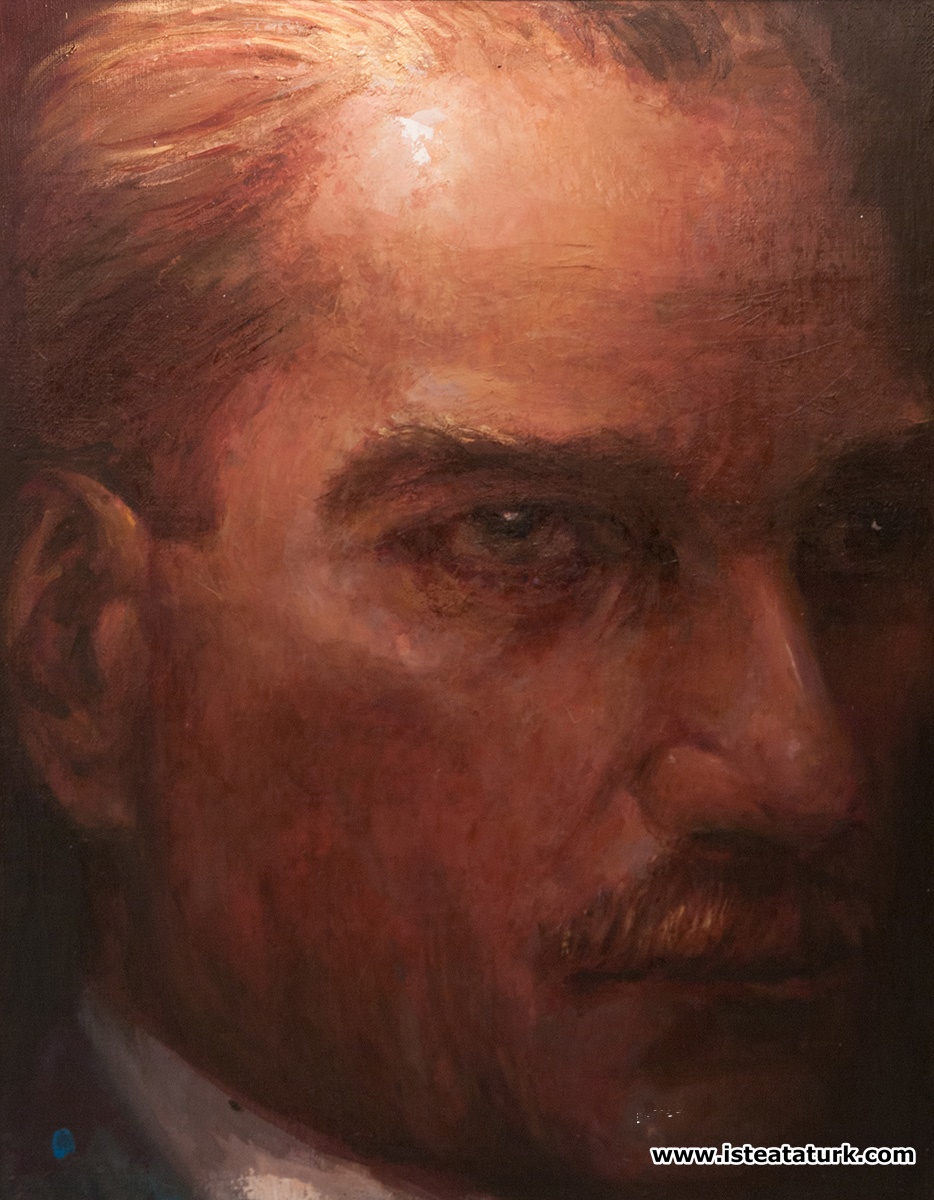
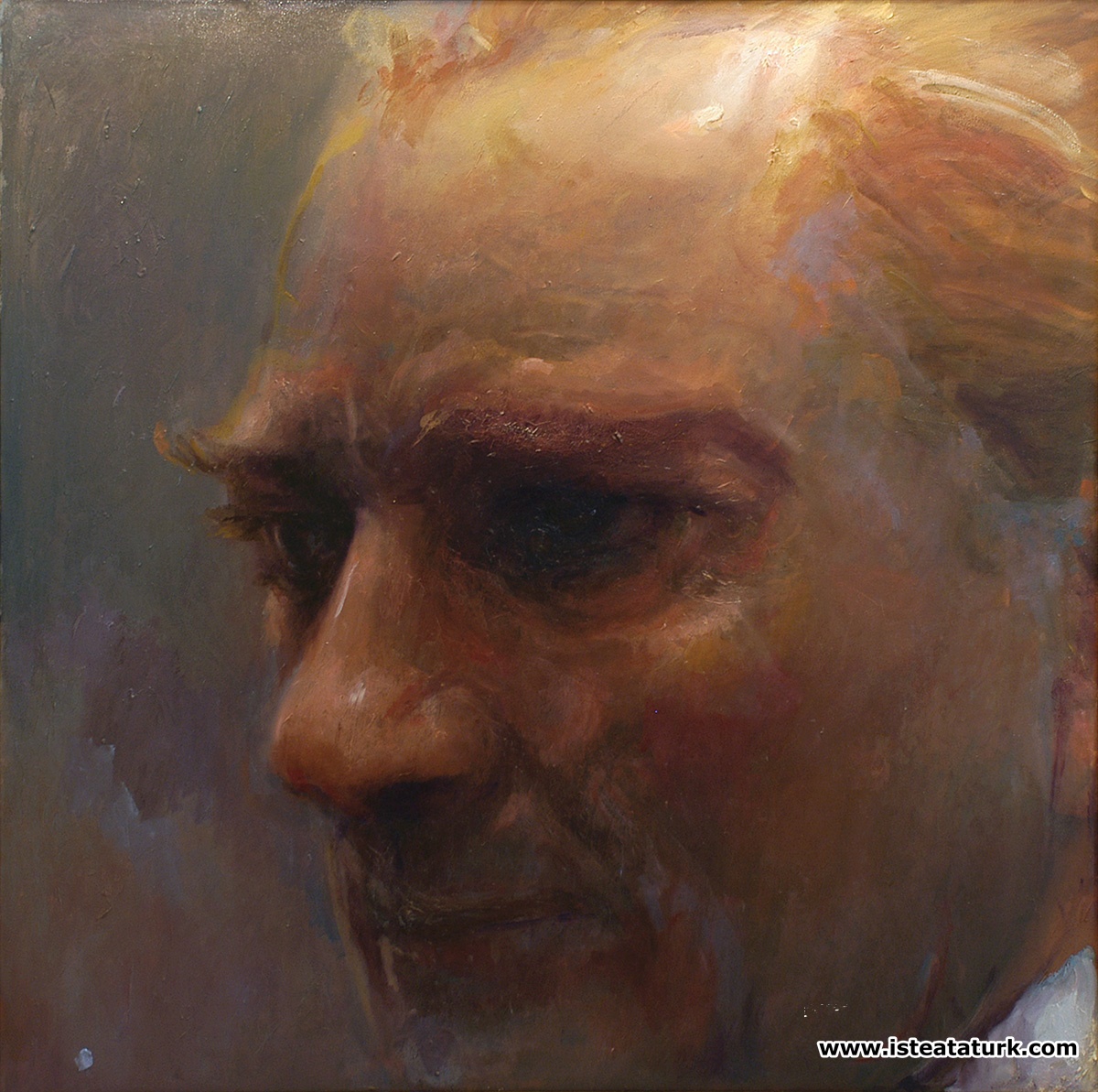
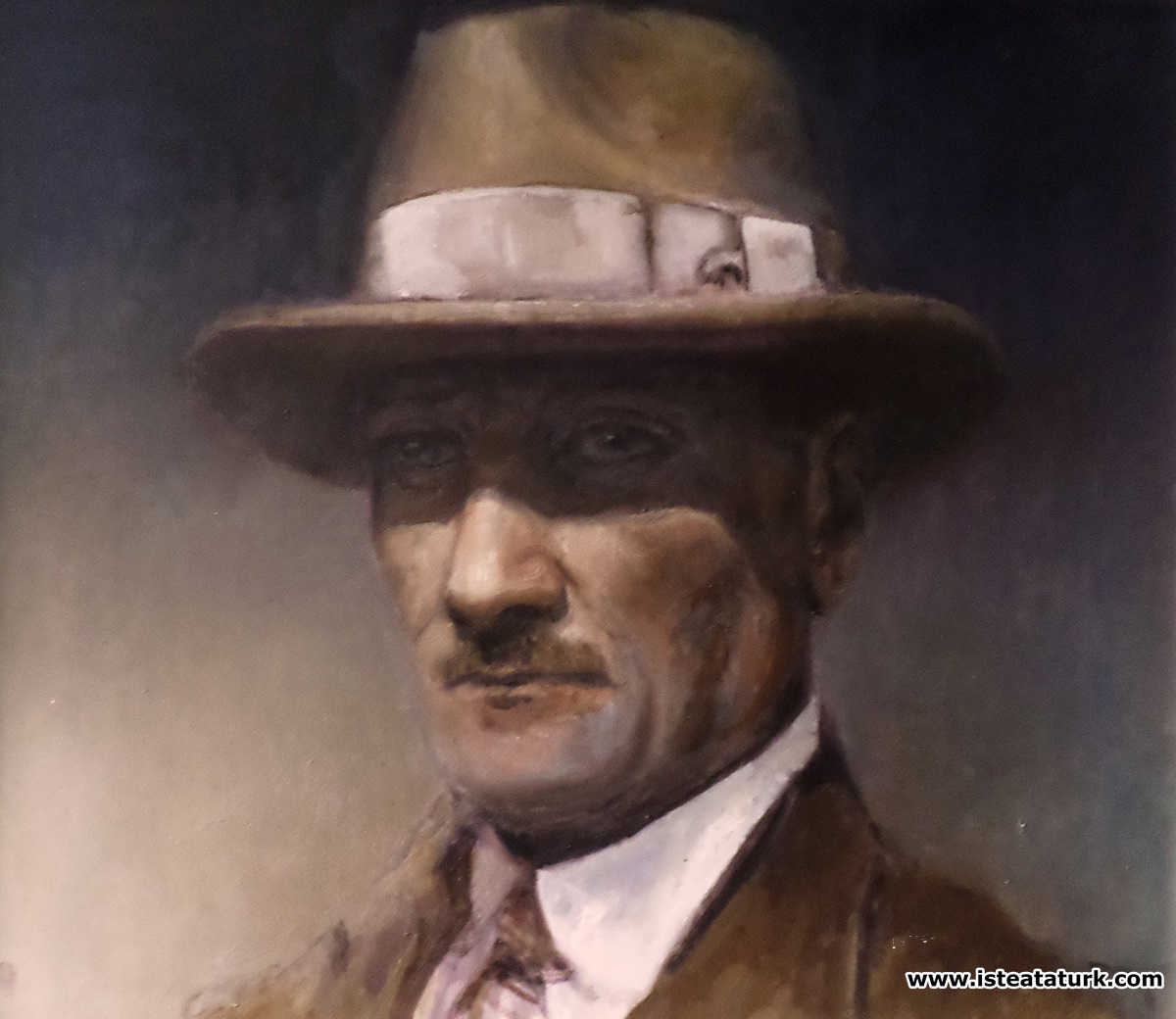
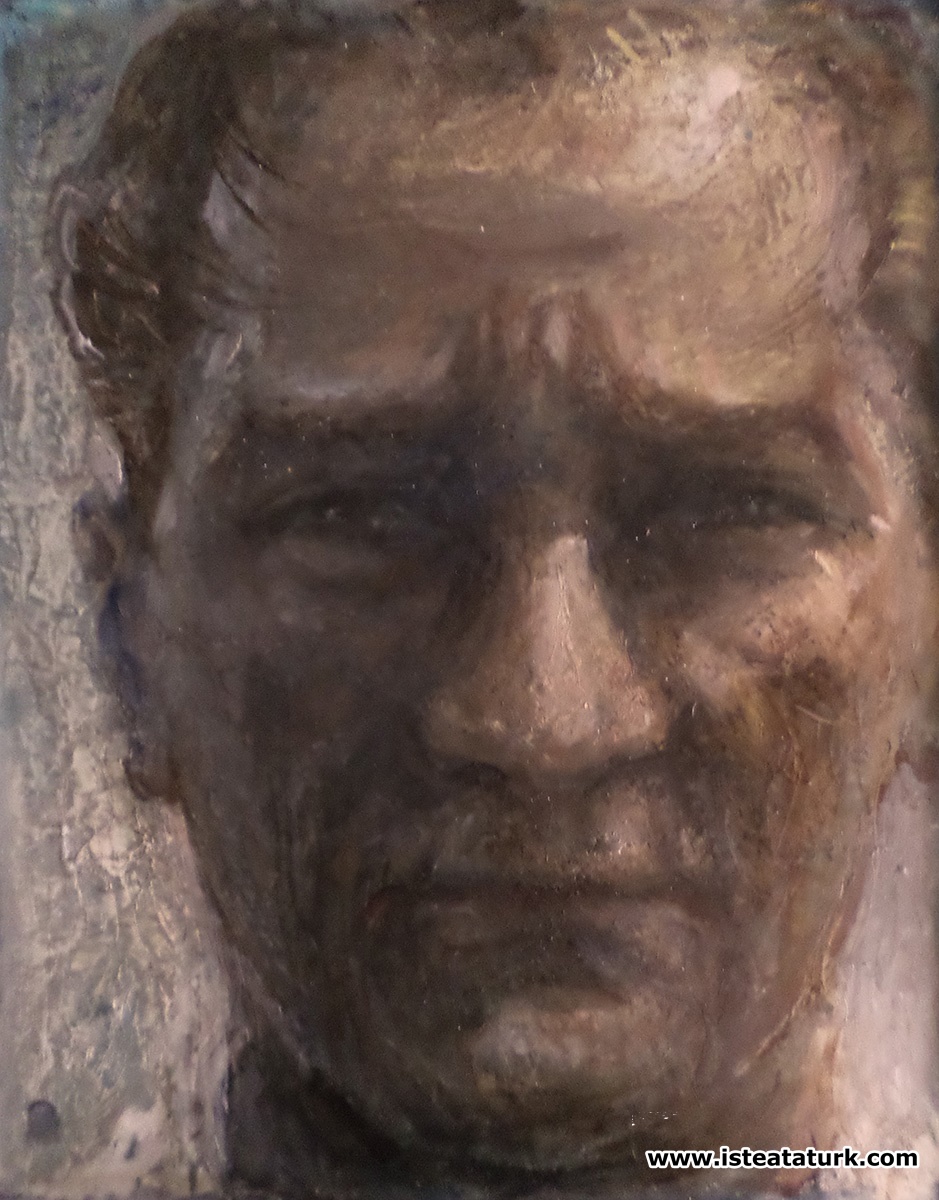
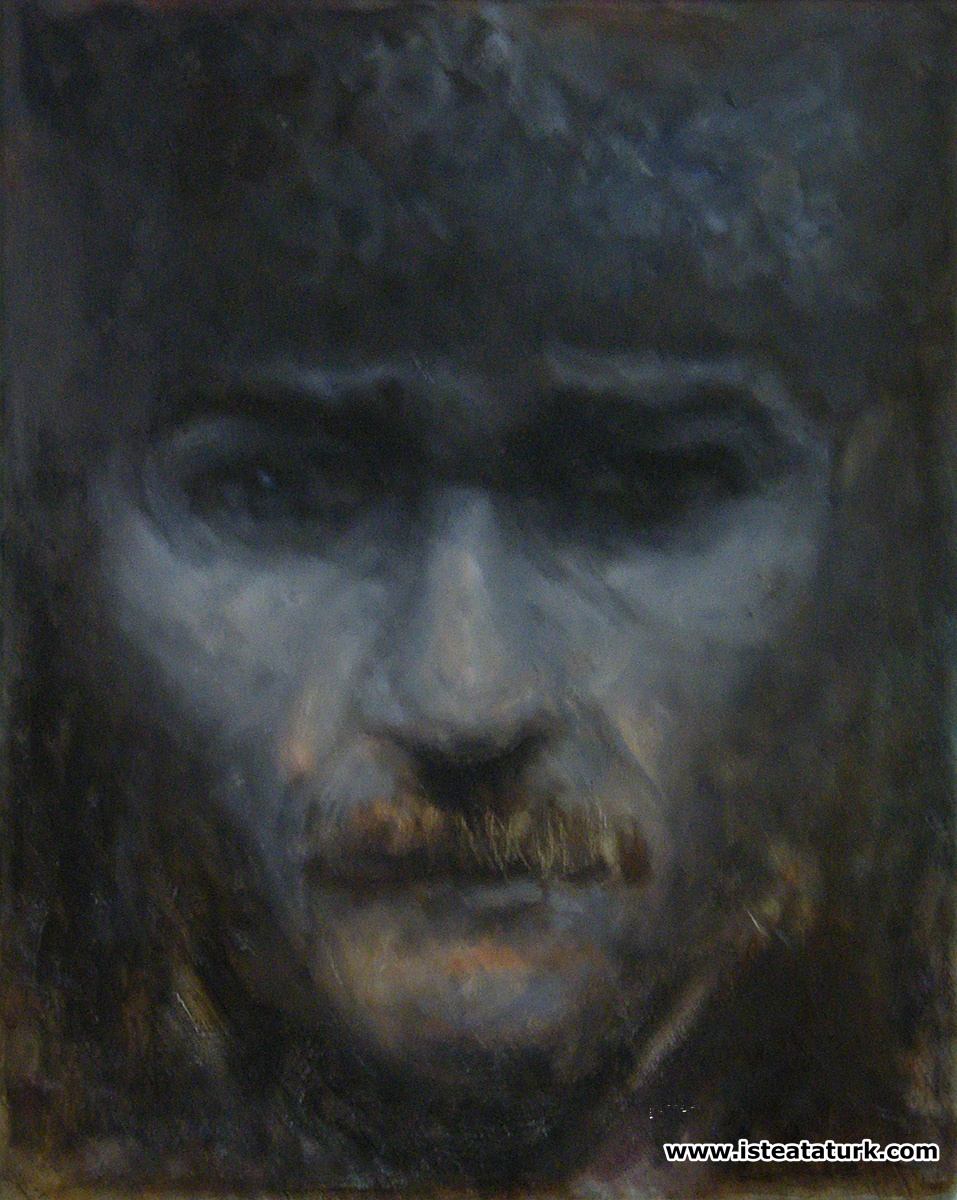
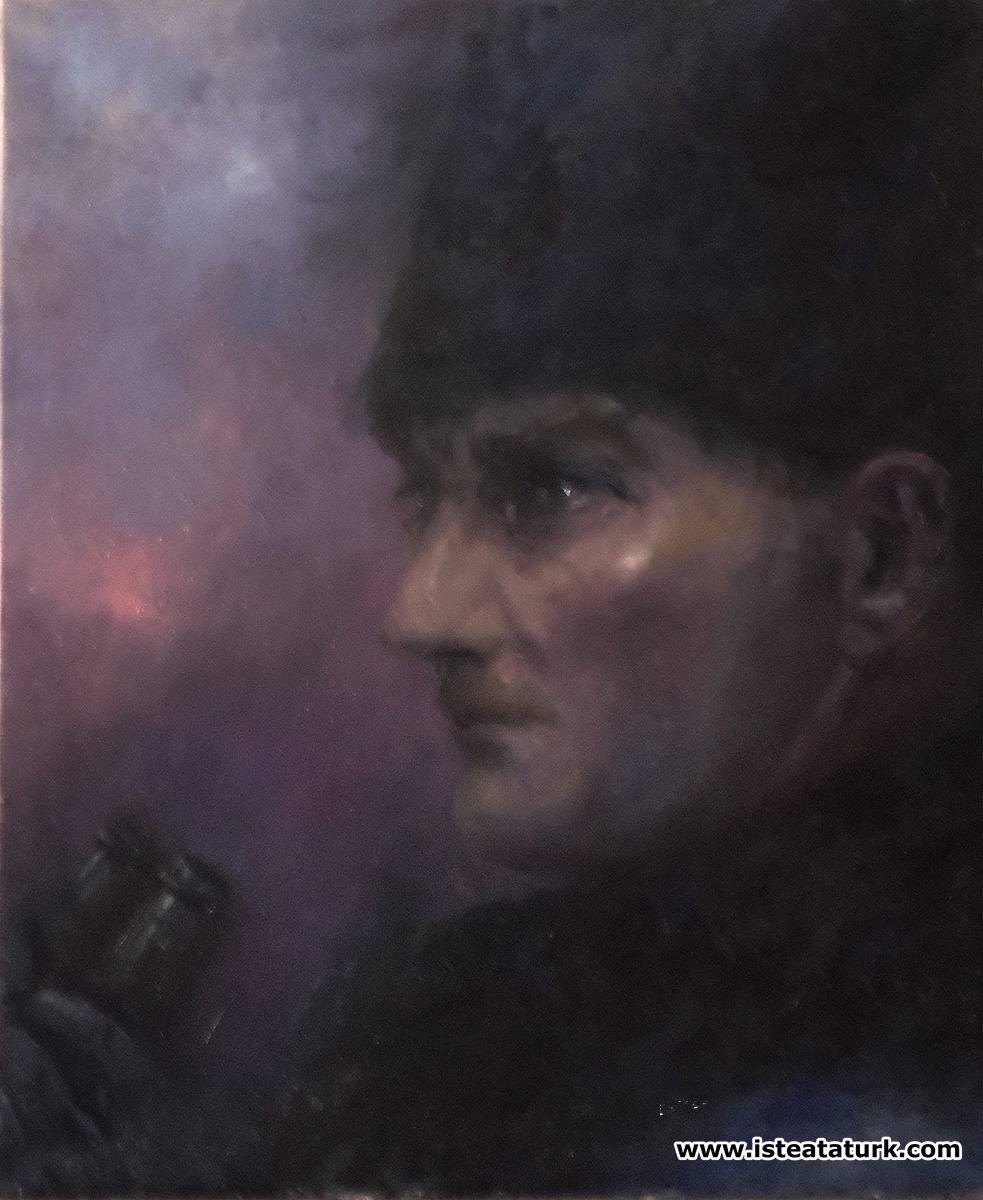
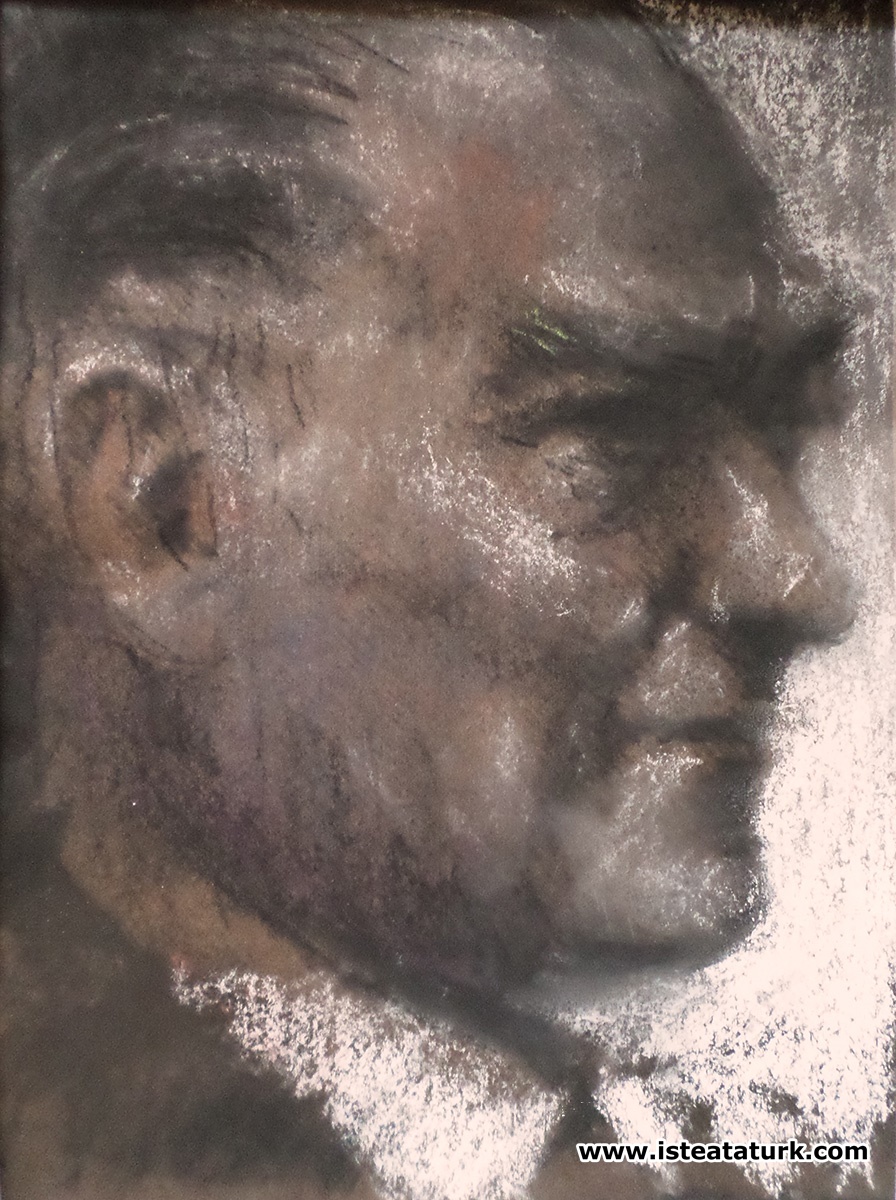
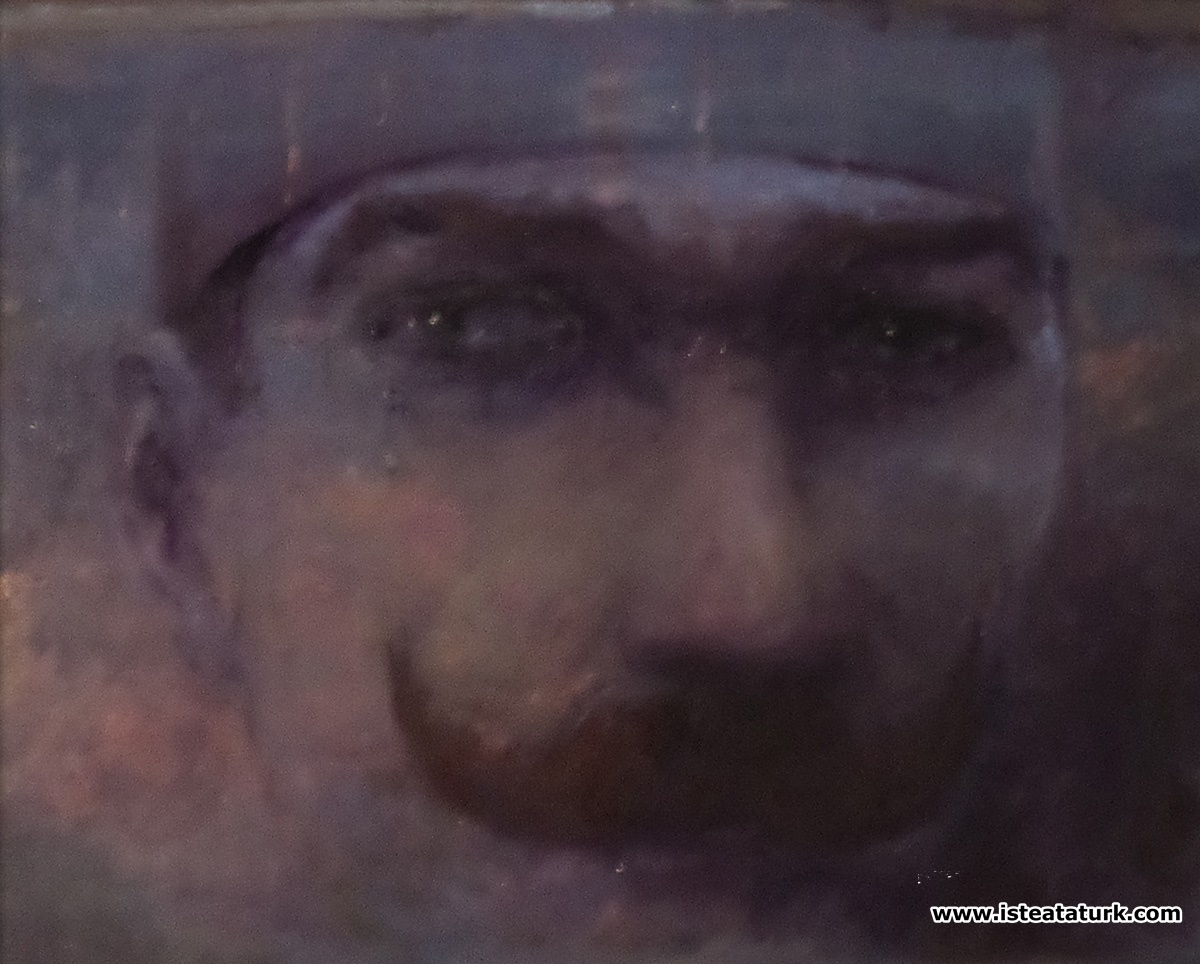
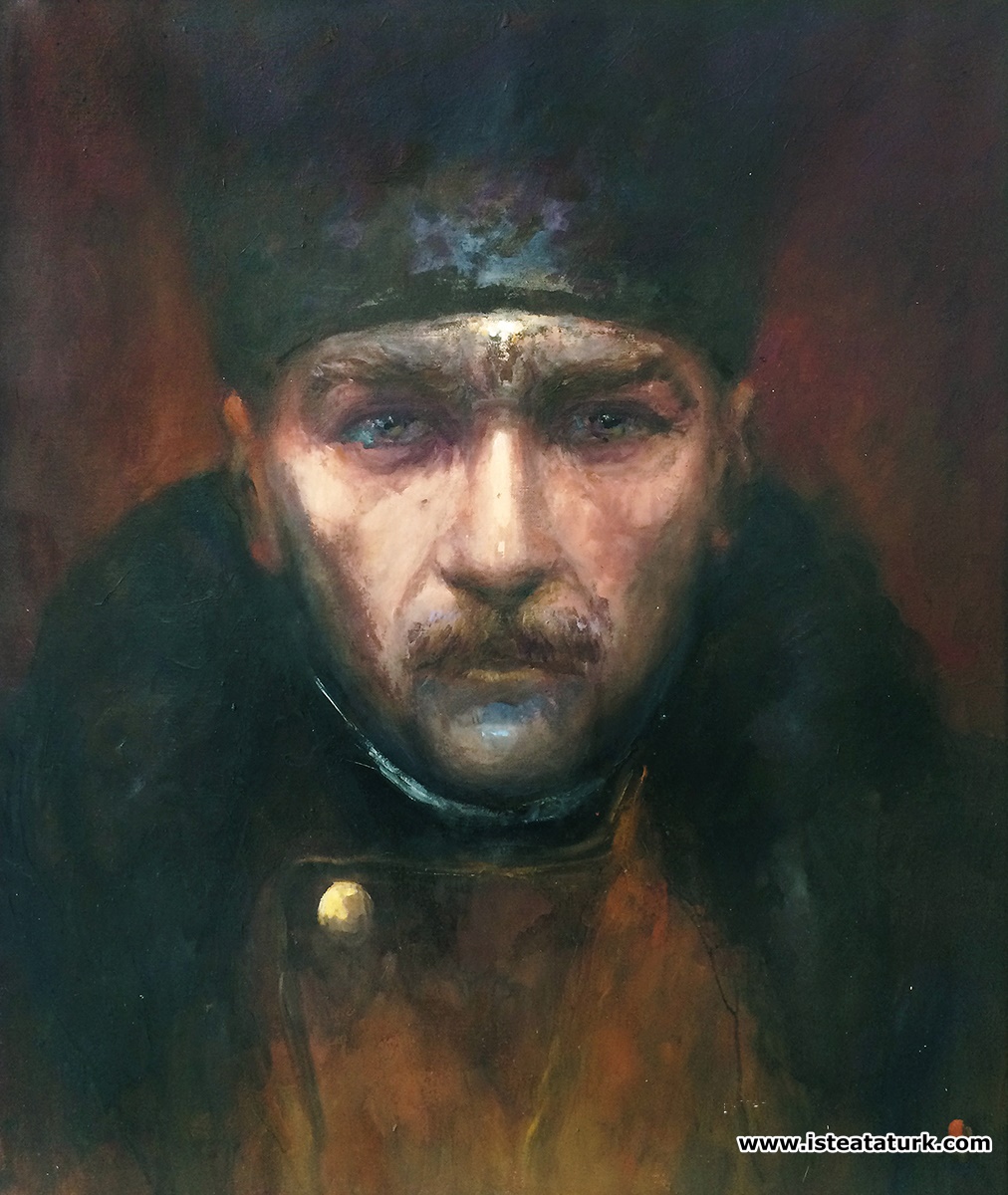
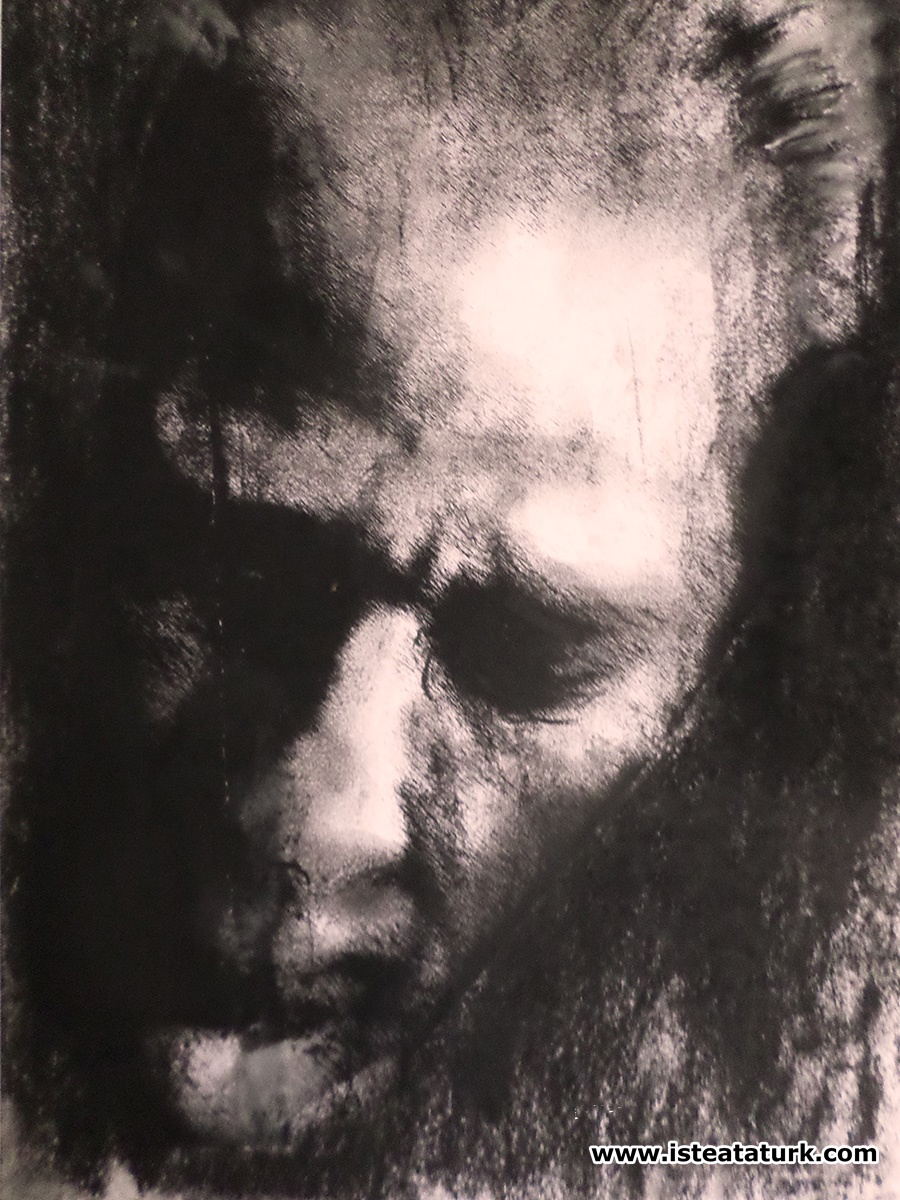
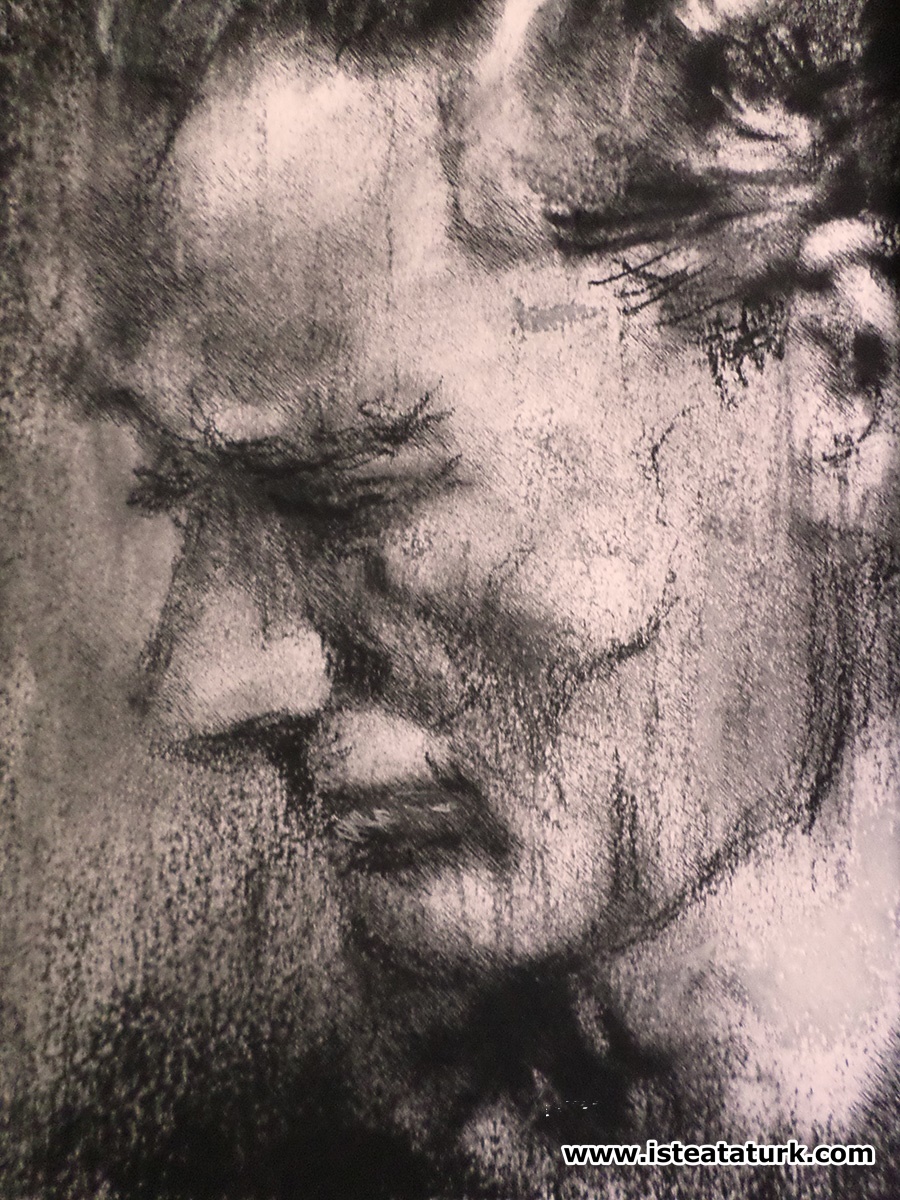
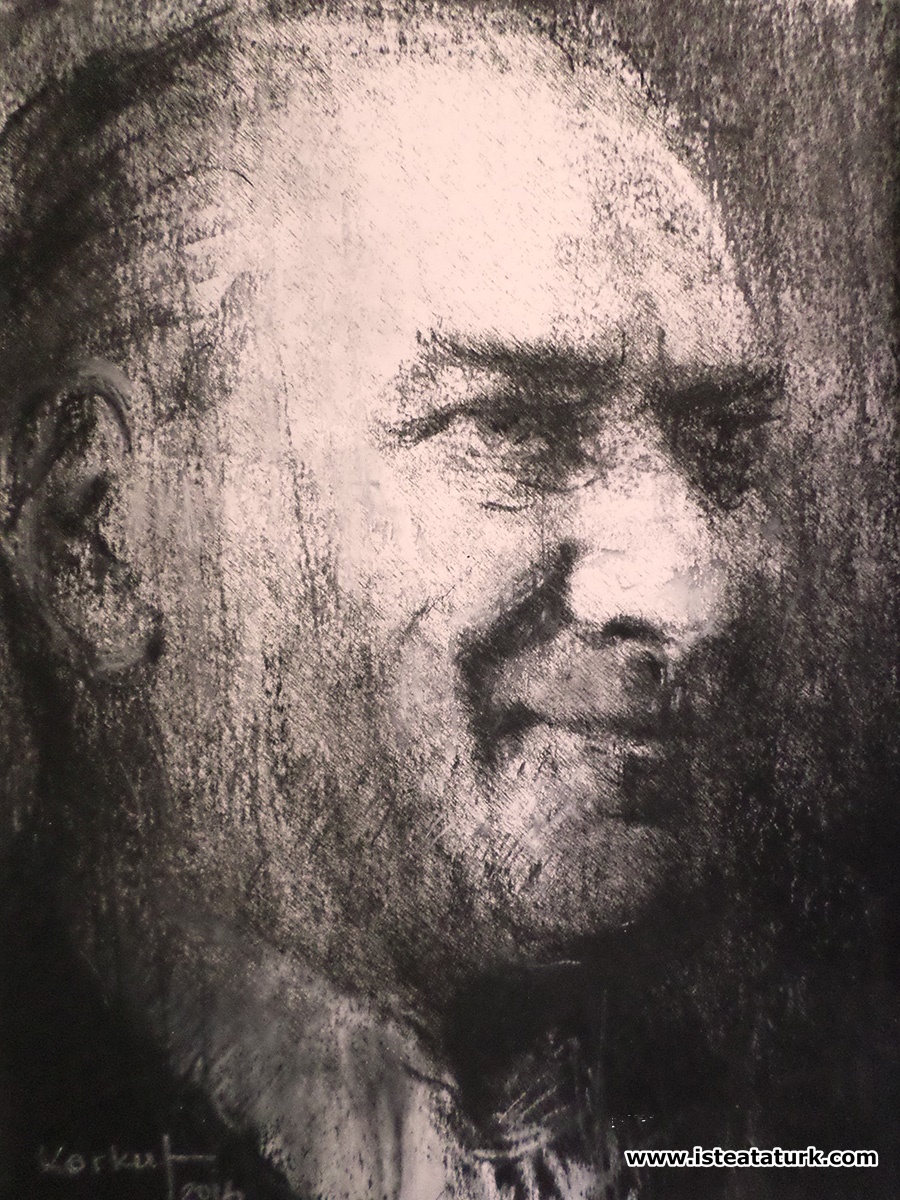
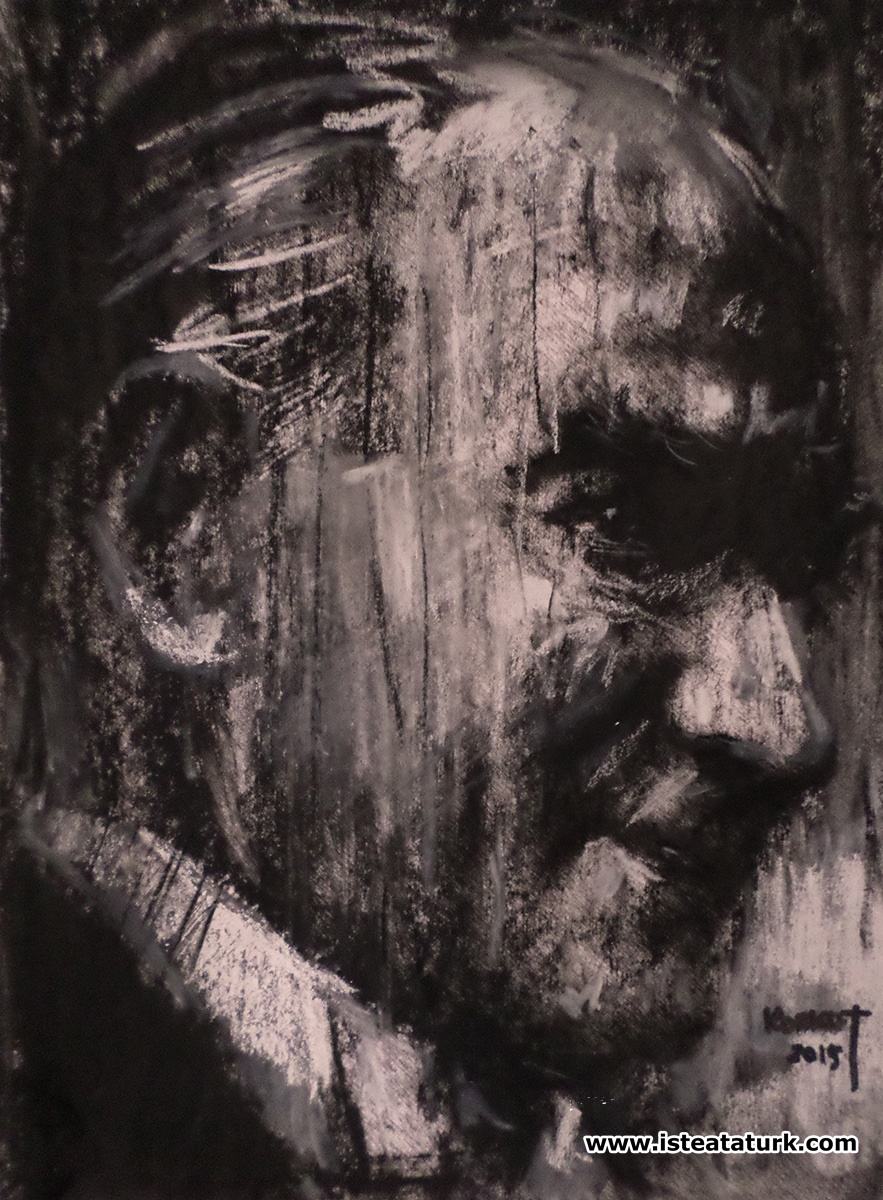
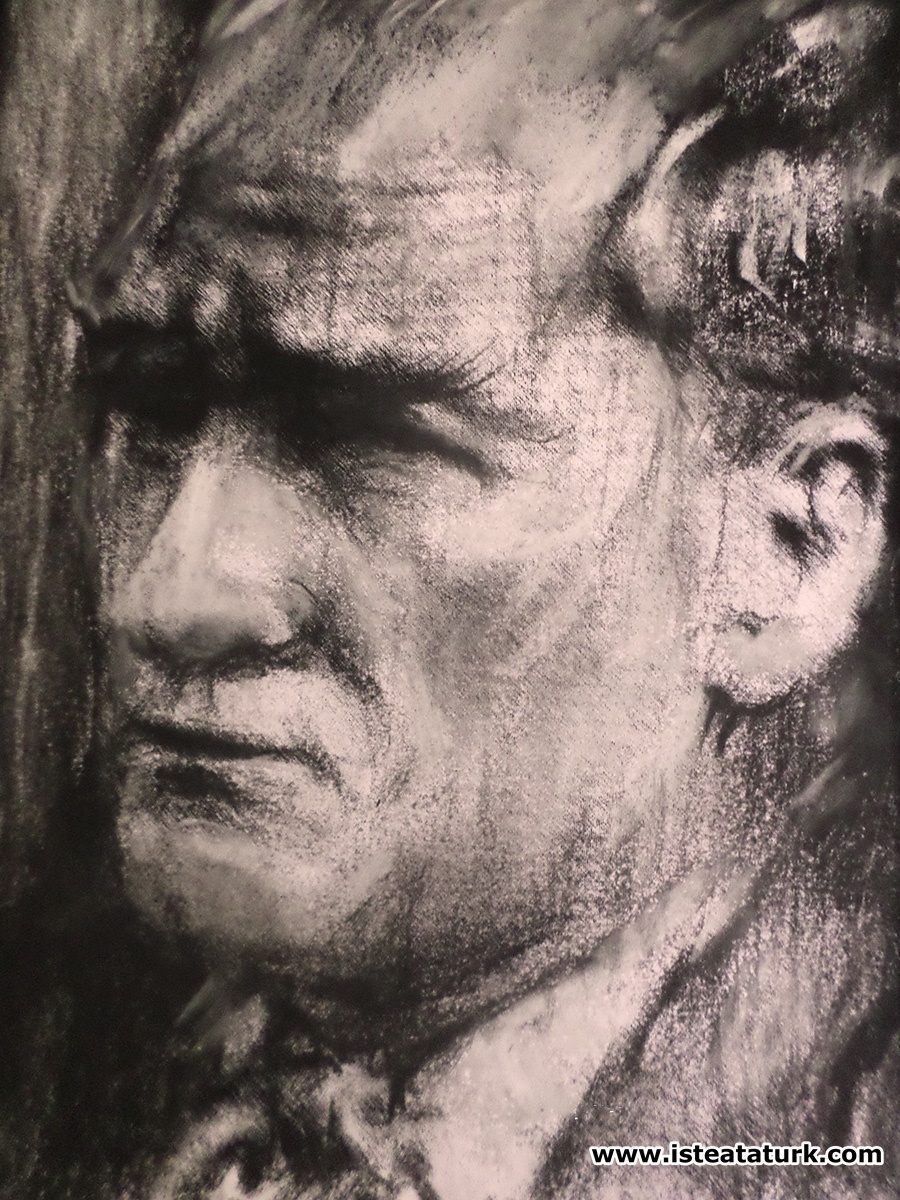
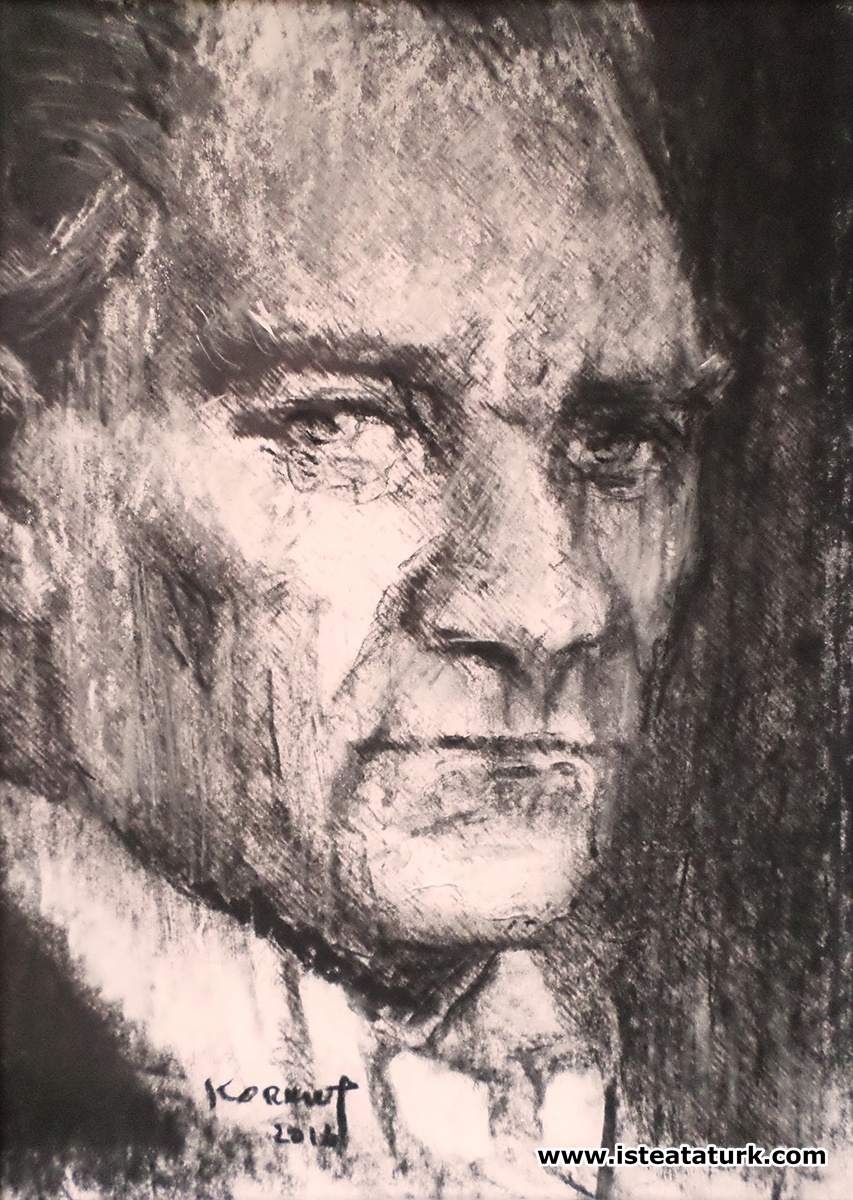
.JPG)
.JPG)
